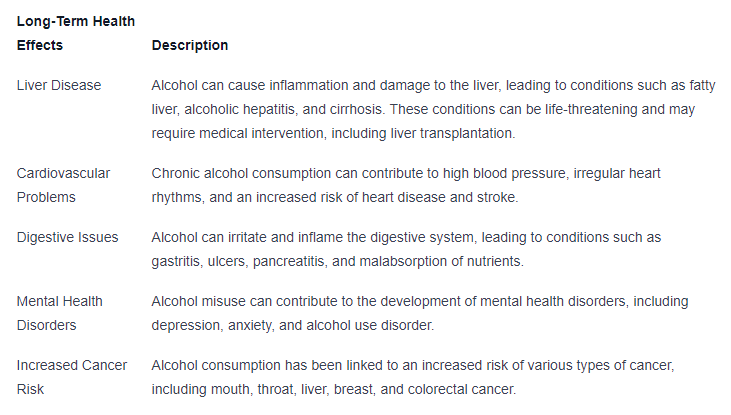What Type of Drug Is Alcohol?

Understanding Alcohol as a Drug
Alcohol is a substance that has a significant impact on the body and mind. In this section, we will explore the concept of drugs, their effects, and whether alcohol falls under this category.
Defining Drugs and Their Effects
Drugs can be defined as substances that alter the normal functioning of the body and mind when consumed. They can affect various bodily systems and have different effects on individuals. Some drugs may produce feelings of euphoria, relaxation, or increased energy, while others may have sedative or hallucinogenic properties.
The effects of drugs can vary depending on the substance, dosage, and individual factors such as body weight, metabolism, and tolerance. It's important to note that not all drugs are illegal. Some drugs, like prescription medications, are used for therapeutic purposes when used under medical supervision.
Is Alcohol Considered a Drug?
Yes, alcohol is considered a drug. It is classified as a psychoactive substance due to its ability to alter brain function and produce changes in behavior and perception. Alcohol is derived from fermented fruits, grains, or other plant materials and contains ethanol, which is responsible for its intoxicating effects.
Alcohol is legal and widely available in many countries for recreational consumption by individuals of legal drinking age. However, it's important to recognize that alcohol, like other drugs, can have both short-term and long-term effects on the body and can lead to addiction and health complications with excessive or irresponsible use.
To better understand the classification of alcohol, let's explore its legal classification and its effects on the body in the following sections.
Alcohol's Classification
Alcohol, a widely consumed substance, is classified both legally and pharmacologically. Understanding its classification helps us grasp its nature and effects.
Legal Classification of Alcohol
From a legal standpoint, alcohol is regulated differently across countries and regions. In many parts of the world, including the United States, alcohol is legal for consumption and sale to individuals of legal drinking age. However, specific regulations regarding the legal drinking age and where alcohol can be consumed may vary.
Alcohol as a Depressant
Pharmacologically, alcohol is classified as a depressant. Depressants, also known as central nervous system depressants or sedatives, are substances that slow down brain activity and suppress the central nervous system. This class of drugs includes various substances, such as alcohol, benzodiazepines, and barbiturates.
Alcohol's depressant effects are evident in its ability to impair cognitive function, coordination, and judgment. It can induce relaxation and drowsiness, which is why it is often used socially for its perceived calming effects. However, it's important to note that excessive consumption of alcohol can lead to a range of health risks and adverse effects.
To better understand the effects of alcohol on the body, let's explore its impact on the central nervous system and the short-term and long-term effects in the following section.
How Alcohol Affects the Body
Understanding how alcohol affects the body is crucial in recognizing its classification as a drug. Alcohol has a significant impact on the central nervous system and can cause various short-term and long-term effects.
Central Nervous System Depressant
Alcohol is classified as a central nervous system depressant. It acts on the brain by slowing down its activity and reducing the transmission of nerve impulses. This depressant effect is responsible for the characteristic changes in behavior and cognition associated with alcohol consumption.
When alcohol enters the bloodstream, it travels to the brain, where it interacts with neurotransmitters, particularly gamma-aminobutyric acid (GABA). GABA is an inhibitory neurotransmitter that helps regulate brain activity. Alcohol enhances the effects of GABA, resulting in feelings of relaxation, sedation, and reduced inhibitions.
Short-Term and Long-Term Effects
Alcohol consumption can have both immediate and long-term effects on the body. The effects depend on various factors, including the amount and frequency of alcohol consumed, individual tolerance levels, and overall health.
Short-Term Effects
Short-Term Effects
Slurred speech
Impaired judgment
Coordination difficulties
Drowsiness
Altered mood
Memory lapses
Nausea and vomiting
Short-term effects of alcohol consumption are usually felt within a short period after drinking and can vary based on the individual's blood alcohol concentration (BAC). These effects can impair motor skills, decision-making abilities, and cognitive function. It's important to note that even a moderate amount of alcohol can have noticeable short-term effects.
Long-Term Effects
Long-Term Effects
Liver damage (such as cirrhosis)
Cardiovascular problems
Increased risk of certain cancers
Impaired immune function
Nutritional deficiencies
Neurological damage
Addiction and dependence
Long-term alcohol consumption can lead to serious health consequences. Prolonged alcohol abuse can cause liver damage, such as cirrhosis, and increase the risk of cardiovascular problems and certain types of cancer. It can also weaken the immune system, leading to a higher susceptibility to infections. Nutritional deficiencies and neurological damage are also potential long-term effects.
Understanding how alcohol affects the body is essential in recognizing its potential risks and consequences. It is important to consume alcohol responsibly and in moderation to minimize the short-term and long-term effects on overall health and well-being. If you or someone you know is struggling with alcohol abuse, seeking professional help and support is crucial for treatment and recovery.
Alcohol and Addiction
Alcohol, despite its widespread use and legal status, can lead to addiction and dependence in individuals who consume it regularly. Understanding the concept of alcohol use disorder and the physical and psychological dependence it can create is essential in recognizing the potential risks and seeking appropriate support.
Alcohol Use Disorder
Alcohol use disorder (AUD), commonly known as alcoholism, is a chronic condition characterized by an inability to control or stop drinking despite negative consequences. It is a form of substance use disorder that specifically relates to alcohol consumption. AUD can range from mild to severe, depending on the impact it has on an individual's life.
To better understand the severity of AUD, healthcare professionals often refer to the DSM-5 (Diagnostic and Statistical Manual of Mental Disorders, 5th Edition) criteria. These criteria include factors such as impaired control over drinking, increased tolerance, withdrawal symptoms, and continued alcohol use despite negative physical or psychological effects. Meeting two or more of these criteria within a 12-month period may indicate the presence of AUD.
Physical and Psychological Dependence
Addiction to alcohol involves both physical and psychological dependence. Physical dependence occurs when the body becomes accustomed to the presence of alcohol and experiences withdrawal symptoms when alcohol consumption is discontinued. These symptoms can include tremors, nausea, sweating, and even seizures in severe cases.
Psychological dependence, on the other hand, refers to the emotional and mental reliance on alcohol. Individuals with psychological dependence may experience intense cravings for alcohol and may find it challenging to cope with daily life without consuming it.
It is important to note that addiction and dependence can vary among individuals. Factors such as genetics, environment, and personal circumstances can influence the development and severity of alcohol-related problems.
Understanding the nature of alcohol addiction and dependence is critical in promoting awareness and encouraging individuals to seek help. Recognizing the signs of AUD and understanding the potential risks and consequences can pave the way for appropriate treatment and recovery options.
Health Risks and Consequences
Understanding the health risks and consequences associated with alcohol consumption is crucial. While alcohol may be legal and socially accepted in many cultures, it can have detrimental effects on both immediate and long-term health. Let's explore the immediate risks and long-term health effects of alcohol consumption.
Immediate Risks of Alcohol Consumption
When consumed in excessive amounts or in certain situations, alcohol can pose immediate risks to an individual's health and safety. These risks include:

To minimize the immediate risks associated with alcohol consumption, it is important to drink in moderation, be aware of personal limits, and avoid engaging in activities that require alertness and coordination when under the influence of alcohol.
Long-Term Health Effects
Consistent and excessive alcohol consumption can lead to severe long-term health effects. Prolonged alcohol use can increase the risk of various health issues, including:

It's important to note that the risks and severity of these long-term health effects can vary based on factors such as the amount of alcohol consumed, the frequency of consumption, and individual susceptibility. To protect long-term health, it is advisable to consume alcohol in moderation or abstain from it altogether.
Understanding the immediate risks and long-term health consequences of alcohol consumption is crucial for making informed decisions about alcohol use. If you or someone you know is struggling with alcohol-related issues, it is important to seek help and support from healthcare professionals and support networks.
Seeking Help and Support
When it comes to dealing with alcohol-related issues, recognizing that there is a problem is the first step towards seeking help and support. It's important to understand the signs and symptoms of alcohol misuse or addiction and to know that there are various treatment and recovery options available.
Recognizing a Problem
Recognizing that alcohol has become a problem in one's life can be challenging. However, there are certain signs and symptoms that can indicate an issue with alcohol. These may include:
If you or someone you know is experiencing these signs, it is important to seek professional help and support.
Treatment and Recovery Options
There are various options available for individuals seeking help and support for alcohol-related issues. The choice of treatment depends on the severity of the problem and individual circumstances. Some common treatment and recovery options include:
It's important to remember that recovery is a unique journey for each individual. What works for one person may not work for another. Seeking professional guidance and support from healthcare professionals, counselors, and support groups can provide the necessary tools and resources to overcome alcohol-related problems.
By recognizing the problem and exploring the various treatment and recovery options available, individuals can take the first steps towards a healthier, alcohol-free life.
Conclusion
Alcohol is a widely consumed substance that has both legal and pharmacological classifications. As a depressant, it can affect the central nervous system and lead to short-term and long-term health consequences. It can also lead to addiction and dependence in individuals who consume it regularly. Recognizing the potential risks and consequences associated with alcohol consumption is crucial in making informed decisions about its use. Seeking professional help and support for alcohol-related issues is essential for treatment and recovery.
In conclusion, understanding the nature of alcohol consumption, its effects on the body, and the potential risks involved is crucial in promoting responsible use. While alcohol may be socially accepted in many cultures, it's essential to recognize its classification as a drug and take steps to minimize harm. By seeking help and support when necessary, individuals can overcome alcohol-related problems and pave the way towards a healthier lifestyle.
Sources:
- https://www.niaaa.nih.gov/publications/brochures-and-fact-sheets/alcohol-facts-and-statistics
- https://pubmed.ncbi.nlm.nih.gov/29470116/
- https://www.who.int/news-room/fact-sheets/detail/alcohol
- https://www.cdc.gov/alcohol/fact-sheets/alcohol-use.htm
- https://www.mayoclinic.org/diseases-conditions/alcohol-use-disorder/symptoms-causes/syc-20369243
